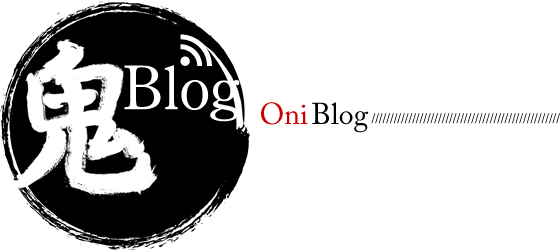Oni Blog

Dreaming of a Big One : Masami Ties His Signature “Oni Kebari”
Posted on | December 13, 2012
I keep myself busy during off-season watching Tenkara videos and tying kebari.
Tying kebari is something I find entertaining but at the same time,
I could easily get lazy about it.
You don’t want to let imagination take off and over-decorate a kebari.
It is Tenkara.
A simple black, yellow or white body is all that’s necessary…
okay, maybe an occasional pattern can go in…
On the hackle, I let my thread go through it a few times to make it…
let’s say “scruffy”.
I like my hackle on the wild side because from my personal experience, it works.
I used Japanese pheasant in the video here, but it’s hard to
find one in the right size.
Some are better for #6 hooks and some would suit #8 better.
You have to go through them carefully and pick out the right size.
I believe in balancing size of the feather to size of the hook.
In terms of size of the body, there’s a balance factor there as well.
Not too thick, or too thin.
You want the body just thick enough for the fish to notice the kebari, and no more.
I like to keep it simple. Many others tie kebari in the same pattern as me
but strangely, they all turn out slightly different.
So the one I make is called “The Oni Kebari”.
In the end though, kebari is much less significant than techniques.
Where and how you present the kebari makes all the difference
and that begins with a proper casting technique.
Stream fishing is tough here in Japan.
The beautiful trout that can be found in streams of Japan are really
running out of places to survive.
Countless dams and other human factors have destroyed too many rivers,
and if there’s any fish left, there are too many anglers to fish for them.
Fish have grown extremely weary of humans and become intelligent
over the years and are not easy to catch.
If they hear or even sense anything unordinary,
they all dive deep and take cover underneath rocks.
They truly are clever, and only the cleverest of them have survived until today.
That’s why it is so satisfying to catch a single fish here.
I hear that there’s more fish in a river in the US and Europe than Japan.
How wonderful would it be, if rivers of Japan could be restored to what it was before.
I wonder what it would take…
COMMENTS
5 Responses to “Dreaming of a Big One : Masami Ties His Signature “Oni Kebari””
Leave a Reply





















March 10th, 2013 @ 10:50 AM
For the sakasa kebari style fly do you prefer a stiff hackle such as rooster or a softer hackle like hen or partridge?
Great blog!
March 13th, 2013 @ 9:07 PM
Dear the tenkara ambasador Thank you for your question.
Masami doesn’t use Sakasa kebari, but most of the time, he prefers soft hackle.
Trout in Japan tend to be smaller than an average fish caught in other countries,
and due to population density trout here are very weary so they bite very carefully.
Stiff hackles are okay for smaller kebari, but for anything larger than size 12,
stiffness in the hackle could cause the kebari to bounce off when a fish goes to
bite. Softer hackles especially in larger kebari would increase the chance of
hooking a fish properly.
Now, going back to Sakasa kebari, you can tug/twitch to lure a fish, or naturally
drifting it also provides success. There’s a reason many prefer to use Sakasa.
If you were to fish for in Japan for trout or in high pressure zone, we would
recommend you to use soft hackle.
Many in the US and in other countries seem to use Tenkara to fish for other
species of fish and fishing environment or fish size differ from Japan.
For certain species of trout or other kinds of fish, it may be better to use stiff
hackle for more aggressive presentation. Even between the native trout of
Japan and the non-native rainbows, type of kebari each specie respond to
differ greatly.
So, we don’t know if this advice made any sense, but you probably will have
to go through certain sets of kebari in different sizes and materials to determine
what works the best for what you’re fishing for.
Just like other kinds of fishing,Tenkara is logical and practical with no ancient
mythical techniques. Please get back to us anytime if you have further questions.
We look forward to hear from you again.
Best Regards,
Masami Sakakibara & Team Oni
June 16th, 2013 @ 1:05 AM
Good video, I got it. I went to Sansui and got hooks on recipe you gave me. Now the flavor goes to the mountains of the southwest US. Thank you so much.
June 22nd, 2014 @ 11:20 PM
I live in Vancouver, British Columbia and many creeks and lakes lost natural fish breeding damaged by industries and people. Now many of the lost creeks and rivers are coming back due to conservation method and cleaning the garbage and heavy metals from the rivers, creeks and lakes. Mostly wild trout only catch and release and some places no fishing at all and only barbless one single hook is allowed for wild fish rivers or creeks. For city population stocked rainbow and cutthroats are released several times in the city area lakes and outside cities, where the pressure too high. The same way wild steelhead and Coho salmon are not allowed to take for eating(catch and release). Our govt woke up little late, but not too late to bring back the beauty of the past
June 23rd, 2014 @ 11:47 AM
Dear baz Yes,We have to think about nature .
Thank you very much, your voice is so great!